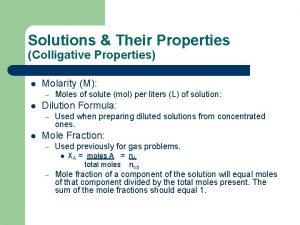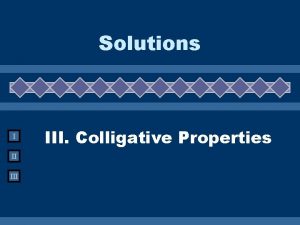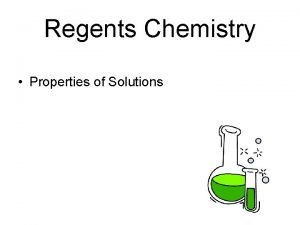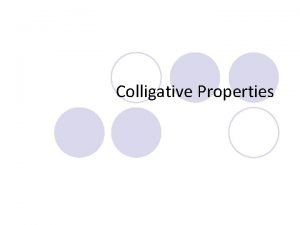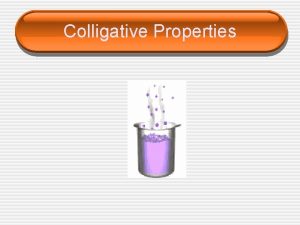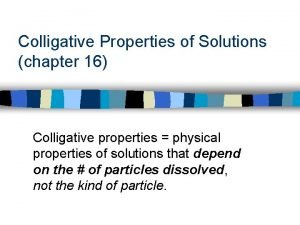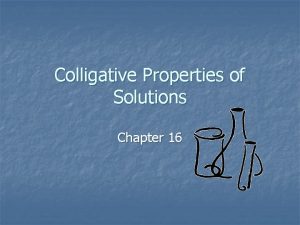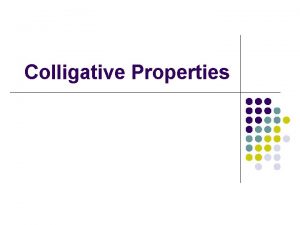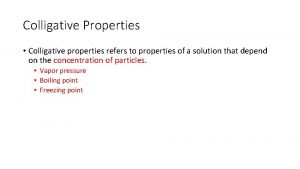Section 4 Colligative Properties of Solutions Colligative properties
















- Slides: 16

Section 4: Colligative Properties of Solutions Colligative properties depend on the number of solute particles in a solution. K What I Know W What I Want to Find Out L What I Learned

• 10(E) Distinguish between types of solutions such as electrolytes and nonelectrolytes and unsaturated, and supersaturated solutions. • 2(I) Communicate valid conclusions supported by the data through methods such as lab reports, labeled drawings, graphs, journals, summaries, oral reports, and technology–based reports. • 3(A) In all fields of science, analyze, evaluate, and critique scientific explanations by using empirical evidence, logical reasoning, and experimental and observational testing, including examining all sides of scientific evidence of those scientific explanations, so as to encourage critical thinking by the student. Copyright © Mc. Graw-Hill Education Colligative Properties of Solutions

Essential Questions • What are colligative properties? • What are four colligative properties of solutions? • How are the boiling point elevation and freezing point depression of a solution determined? Copyright © Mc. Graw-Hill Education Colligative Properties of Solutions

Vocabulary Review New • ion • colligative property • vapor pressure lowering • boiling point elevation • freezing point depression • osmosis • osmotic pressure Copyright © Mc. Graw-Hill Education Colligative Properties of Solutions

Electrolytes and Colligative Properties Colligative properties are physical properties of solutions that are affected by the number of particles but not by the identity of dissolved solute particles. • • Colligative means depending on the collection Colligative properties include: vapor pressure lowering, boiling point elevation, freezing point depression and osmotic pressure. Copyright © Mc. Graw-Hill Education Colligative Properties of Solutions

Electrolytes and Colligative Properties Ionic compounds are electrolytes because they dissociate in water to form a solution that conducts electricity. • • Electrolytes that produce many ions are strong electrolytes. Electrolytes that produce only a few ions are weak electrolytes. Many molecular compounds do not ionize when dissolved, and do not conduct electricity, these are called nonelectrolytes. • There are some exceptions, so those molecular compounds that do ionize are electrolytes. Copyright © Mc. Graw-Hill Education Colligative Properties of Solutions

Vapor Pressure Lowering Vapor pressure lowering is due to the number of solute particles in solution and is a colligative property of solutions. • Adding a nonvolatile solute (one that has little tendency to become a gas) to a solvent lowers the solvent’s vapor pressure. • When a solute is present, a mixture of solvent and solute occupies the surface area, and fewer particles enter the gaseous state. • The greater the number of solute particles, the lower the vapor pressure. Copyright © Mc. Graw-Hill Education Colligative Properties of Solutions

Boiling Point Elevation The temperature difference between a solution’s boiling point and a pure solvent's boiling point is called the boiling point elevation. • When a nonvolatile solute lowers the vapor pressure of a solvent, the boiling point is also affected. • More heat is needed to supply additional kinetic energy to raise the vapor pressure to atmospheric pressure. Copyright © Mc. Graw-Hill Education Colligative Properties of Solutions

Boiling Point Elevation Copyright © Mc. Graw-Hill Education Colligative Properties of Solutions

Freezing Point Depression A solution's freezing point depression is the difference in temperature between its freezing point and the freezing point of the pure solvent. • At a solvent's freezing point temperature, particles no longer have sufficient kinetic energy to overcome interparticle attractive forces. • The freezing point of a solution is always lower than that of the pure solvent. • Solute particles interfere with the attractive forces among solvent particles. Copyright © Mc. Graw-Hill Education Colligative Properties of Solutions

Freezing Point Depression Copyright © Mc. Graw-Hill Education Colligative Properties of Solutions

Freezing Point Depression Copyright © Mc. Graw-Hill Education Colligative Properties of Solutions

CHANGES IN BOILING AND FREEZING POINTS Use with Example Problem 6. Problem Sodium chloride (Na. Cl) is often used to prevent icy roads and to freeze ice cream. What are the boiling and freezing points of a 0. 029 m aqueous solution of sodium chloride? Response ANALYZE THE PROBLEM You are given the molality of an aqueous sodium chloride solution. First, calculate ΔTb and ΔTf based on the number of particles in the solution. Then, to determine the elevated boiling point and the depressed freezing point, add ΔTb to the normal boiling point and subtract ΔTf from the normal freezing point of water. Copyright © Mc. Graw-Hill Education KNOWN UNKNOWN molality of solution = 0. 029 m boiling point = ? °C Kb = 0. 512°C/m freezing point = ? °C Kf = 1. 86°C/m SOLVE FOR THE UNKNOWN Determine the molality of the particles. particle molality = 2 × 0. 029 m = 0. 058 m Determine ΔTb and ΔTf • State the boiling point elevation and freezing point depression formulas. ΔTb = Kbm ΔTf = Kfm Colligative Properties of Solutions

CHANGES IN BOILING AND FREEZING POINTS SOLVE FOR THE UNKNOWN (continued) • Substitute Kb = 0. 512°C/m, Kf = 1. 86°C/m, and m = 0. 058 m. ΔTb = (0. 512°C/m)(0. 058 m) = 0. 030°C ΔTf = (1. 86°C/m)(0. 058 m) = 0. 11°C Determine the elevated boiling point and depressed freezing point of the solution. • Add ΔTb to the normal boiling point and subtract ΔTf from the normal freezing point. EVALUATE THE ANSWER The boiling point is higher and the freezing point is lower, as expected. Because the molality of the solution has two significant figures, both ΔTb and ΔTf have two significant figures. Because the normal boiling point and freezing point are exact values, they do not affect the number of significant figures in the final answer. boiling point = 100. 000°C + 0. 030°C = 100. 030°C freezing point = 0. 00°C - 0. 11°C = -0. 11°C Copyright © Mc. Graw-Hill Education Colligative Properties of Solutions

Osmotic Pressure Osmosis is the diffusion of a solvent through a semipermeable membrane. Osmotic pressure is the amount of additional pressure caused by water molecules that moved into the concentrated solution. Copyright © Mc. Graw-Hill Education Colligative Properties of Solutions

Review Essential Questions • What are colligative properties? • What are four colligative properties of solutions? • How are the boiling point elevation and freezing point depression of a solution determined? Vocabulary • colligative property • vapor pressure lowering Copyright © Mc. Graw-Hill Education • boiling point elevation • freezing point depression • osmosis • osmotic pressure Colligative Properties of Solutions
 Ions in aqueous solutions and colligative properties
Ions in aqueous solutions and colligative properties Why are colligative properties important
Why are colligative properties important Pourcentage massique
Pourcentage massique 4 colligative properties
4 colligative properties Elemental analysis of an unknown pure substance
Elemental analysis of an unknown pure substance Colligative properties definition
Colligative properties definition Colligative properties definition
Colligative properties definition Colligative properties regents questions
Colligative properties regents questions Colligative properties of milk
Colligative properties of milk Colligative properties depend upon the
Colligative properties depend upon the Colligative properties worksheet
Colligative properties worksheet Properties of l
Properties of l Freezing point depression examples in real life
Freezing point depression examples in real life Colligative properties depend on the _____.
Colligative properties depend on the _____. Colligative properties depend on
Colligative properties depend on Calculations involving colligative properties
Calculations involving colligative properties Costherm
Costherm




